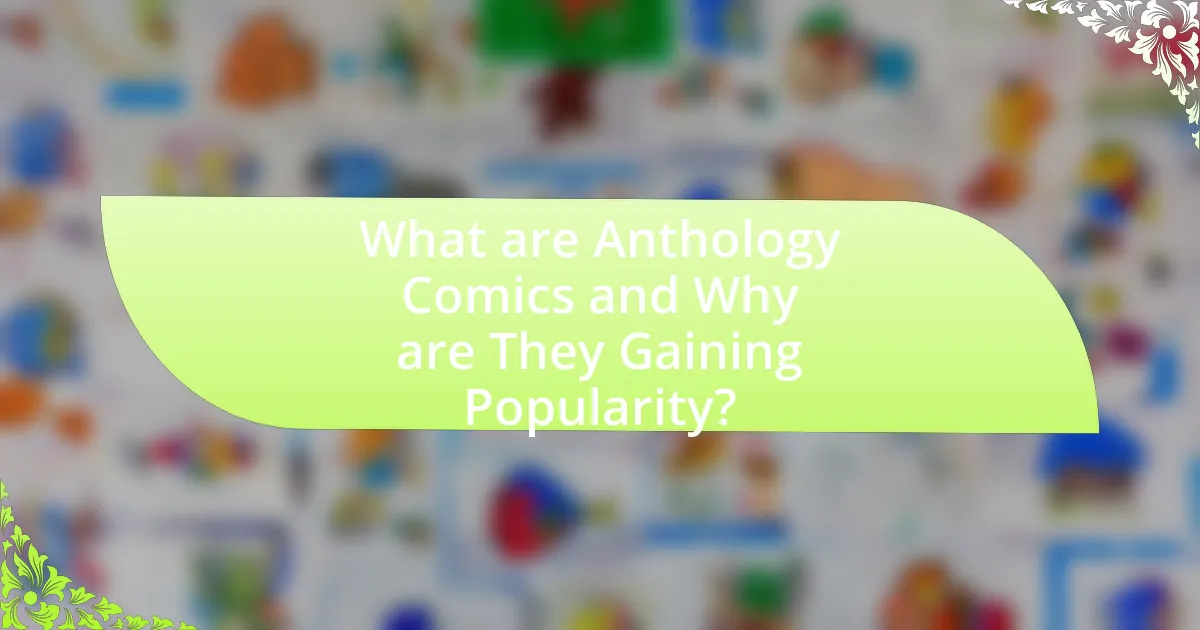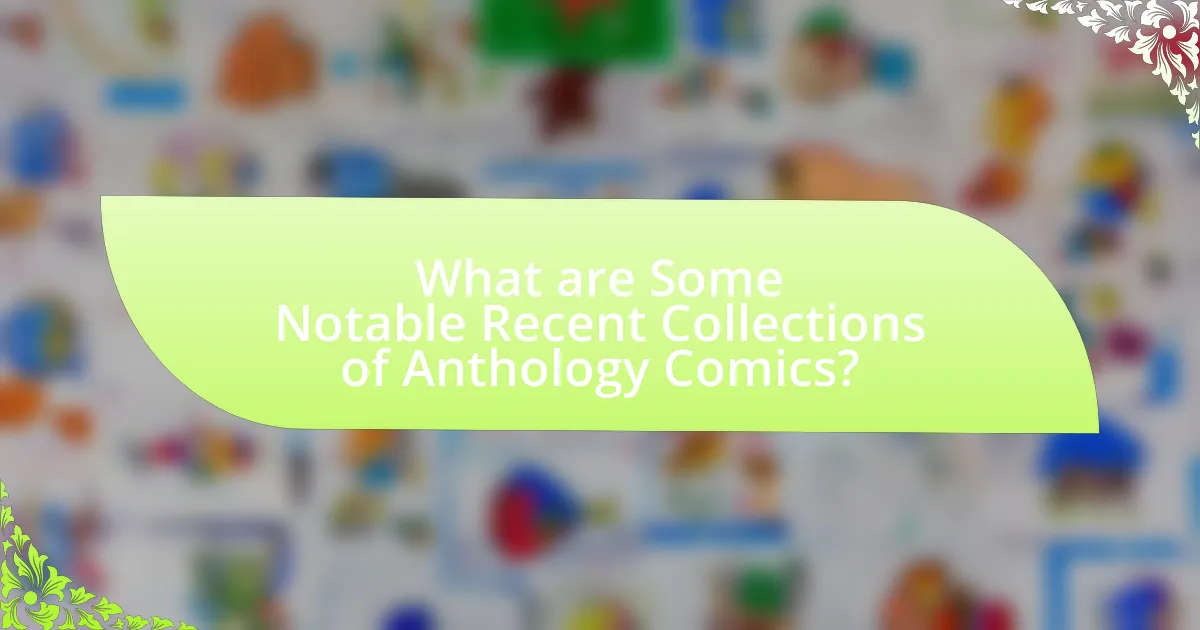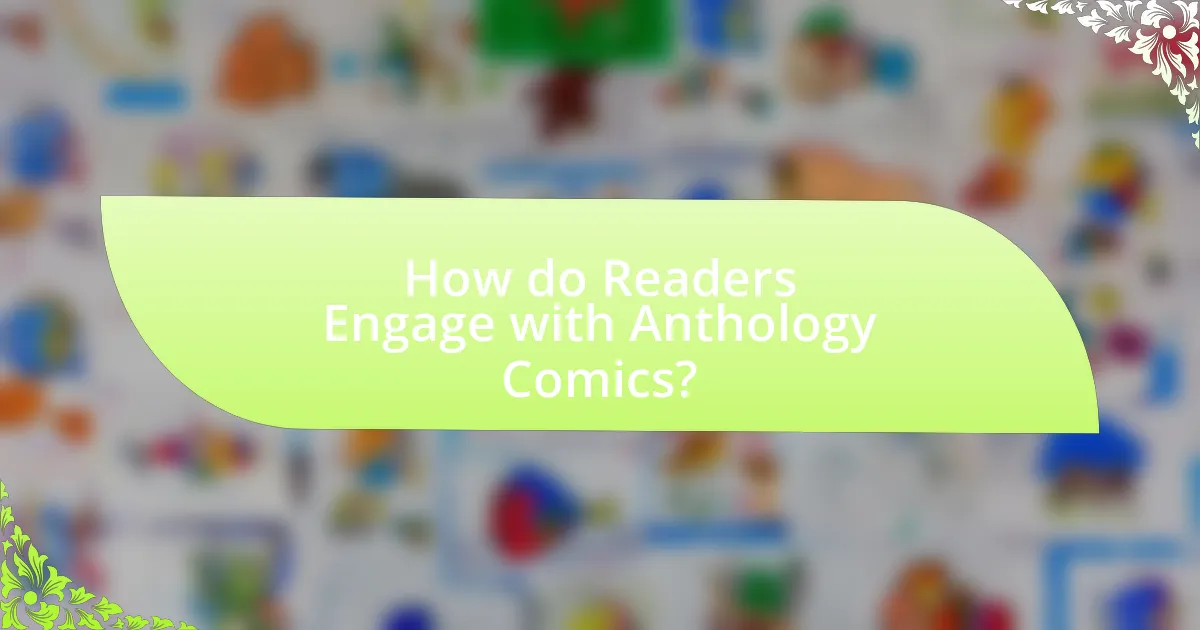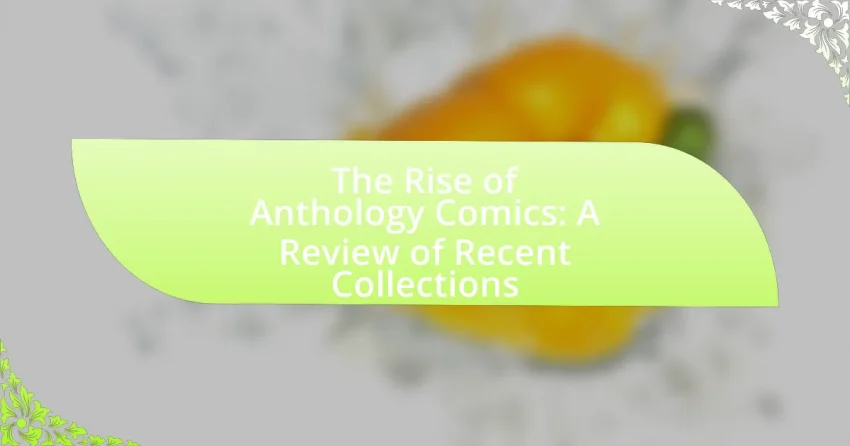Anthology comics are collections of short stories or comic strips that feature various creators and artistic styles within a single volume. Their popularity is rising due to the demand for diverse storytelling and the accessibility provided by digital platforms. This article reviews notable recent collections, explores how anthology comics differ from traditional formats, and highlights the unique storytelling techniques and themes they encompass. It also examines the role of independent creators, the impact of digital distribution, and the challenges faced by anthology comics in the market.

What are Anthology Comics and Why are They Gaining Popularity?
Anthology comics are collections of short stories or individual comic strips, often featuring various creators and styles within a single volume. They are gaining popularity due to their ability to showcase diverse voices and artistic expressions, appealing to a broader audience. The rise of digital platforms has facilitated access to these collections, allowing readers to explore different genres and themes without the commitment of a single narrative. Additionally, the success of recent anthology series, such as “Love is Love” and “The Sandman: Endless Nights,” has demonstrated their commercial viability and cultural relevance, further driving interest in this format.
How do Anthology Comics differ from traditional comics?
Anthology comics differ from traditional comics primarily in their structure and content, as anthology comics compile multiple short stories or works from various creators within a single volume, while traditional comics typically focus on a single narrative or character arc. This format allows anthology comics to showcase diverse styles, genres, and voices, often featuring contributions from different artists and writers, which contrasts with the more uniform storytelling found in traditional comics. For example, notable anthology series like “Love and Rockets” and “The New Yorker” comics have highlighted a range of artistic expressions and themes, demonstrating the versatility and collaborative nature of anthologies compared to the singular focus of traditional comic series.
What unique storytelling techniques are used in Anthology Comics?
Anthology comics utilize unique storytelling techniques such as diverse narrative styles, non-linear storytelling, and thematic cohesion across multiple short stories. These techniques allow for a variety of voices and artistic expressions within a single collection, enabling readers to experience different genres and perspectives. For instance, anthology comics often feature contributions from various writers and artists, which can lead to innovative storytelling methods, such as juxtaposing contrasting narratives or exploring a central theme through multiple lenses. This format has been exemplified in collections like “Love Is Love,” which showcases numerous creators addressing the theme of love and loss, demonstrating how varied storytelling can resonate collectively.
How do Anthology Comics showcase diverse voices and styles?
Anthology comics showcase diverse voices and styles by compiling works from various creators, each contributing unique perspectives and artistic techniques. This format allows for a wide range of narratives, themes, and visual styles, reflecting the multifaceted nature of contemporary society. For instance, collections like “Love is Love” feature stories from over 140 different creators, highlighting LGBTQ+ experiences and issues, thereby amplifying underrepresented voices. Additionally, anthologies such as “The Best American Comics” series curate selections that span genres and cultural backgrounds, demonstrating the breadth of storytelling in the medium. This diversity not only enriches the reading experience but also fosters inclusivity within the comic book industry.
What factors have contributed to the rise of Anthology Comics?
The rise of anthology comics has been significantly influenced by the increasing demand for diverse storytelling and the accessibility of digital platforms. The shift in consumer preferences towards varied narratives has led publishers to curate collections that showcase multiple voices and styles, appealing to a broader audience. Additionally, the growth of webcomics and digital distribution has lowered barriers for creators, allowing independent artists to contribute to anthologies, thereby enriching the medium. This trend is supported by the success of notable anthology series, which have garnered critical acclaim and commercial success, demonstrating the viability of this format in contemporary comics.
How has the digital age influenced the popularity of Anthology Comics?
The digital age has significantly increased the popularity of anthology comics by providing broader access and distribution channels. Digital platforms allow creators to reach global audiences without the limitations of traditional print distribution, leading to a surge in diverse voices and stories. For instance, platforms like ComiXology and Webtoon have facilitated the publication of numerous anthology collections, making them easily accessible to readers. Additionally, social media has enabled creators to promote their work directly to fans, fostering community engagement and increasing visibility. This shift has resulted in a notable rise in readership and sales for anthology comics, as evidenced by the growing number of digital-first anthology releases in recent years.
What role do independent creators play in the Anthology Comics movement?
Independent creators are essential to the Anthology Comics movement as they bring diverse voices and innovative storytelling techniques to the medium. Their contributions often challenge mainstream narratives and explore underrepresented themes, enriching the overall landscape of comics. For instance, anthologies like “The Best American Comics” showcase works from independent artists, highlighting their unique perspectives and artistic styles. This inclusion not only broadens the audience’s understanding of the medium but also fosters a community of creators who support one another, as seen in collaborative projects like “The Comics Workbook” and “The Nib.”

What are Some Notable Recent Collections of Anthology Comics?
Some notable recent collections of anthology comics include “The Best American Comics 2022,” edited by Alison Bechdel, which showcases a diverse range of contemporary comic artists and styles. Another significant collection is “The New Yorker: The Cartoon Album,” featuring a curated selection of cartoons from the magazine, highlighting the work of various cartoonists. Additionally, “Drawn & Quarterly: The Anthology” compiles a variety of stories from different creators, emphasizing the evolution of graphic storytelling. These collections reflect the growing popularity and artistic diversity within the anthology comic format.
Which recent Anthology Comics have received critical acclaim?
Recent anthology comics that have received critical acclaim include “The Best American Comics 2023,” which showcases a diverse range of voices and styles, and “Black Comics: The Collection,” praised for its representation and storytelling. Both anthologies have been highlighted in reviews for their innovative approaches and significant contributions to the comic medium, with “The Best American Comics 2023” being recognized for its editorial excellence and “Black Comics: The Collection” for its cultural impact and depth.
What themes are explored in these acclaimed Anthology Comics?
Acclaimed anthology comics explore themes such as identity, social justice, and the human experience. These collections often feature diverse voices and perspectives, reflecting contemporary societal issues and personal narratives. For instance, works like “Love is Love” address LGBTQ+ rights and representation, while “The Best American Comics” series showcases a variety of storytelling styles that highlight cultural and political themes. This thematic exploration not only enriches the medium but also engages readers in critical conversations about the world around them.
How do the artistic styles in these collections vary?
The artistic styles in these collections vary significantly, reflecting diverse influences and techniques. For instance, some collections feature minimalist art with a focus on line work and negative space, while others employ vibrant colors and detailed illustrations that enhance narrative depth. This variation is evident in works like “The Best American Comics” series, which showcases a range of styles from traditional comic art to experimental forms, highlighting the evolution of visual storytelling in contemporary comics. Additionally, the inclusion of different cultural perspectives contributes to the stylistic diversity, as seen in anthologies that incorporate international artists, each bringing unique aesthetics and cultural motifs to the forefront.
What are the key features of successful Anthology Comics collections?
Successful anthology comics collections typically feature diverse storytelling, high-quality artwork, and a cohesive theme. Diverse storytelling allows for a range of voices and genres, appealing to a broader audience; for instance, collections like “Love is Love” showcase various narratives around a central topic, enhancing relatability. High-quality artwork is essential, as it attracts readers and enhances the storytelling experience; collections such as “The Best American Comics” highlight exceptional artistic talent, which elevates the overall presentation. A cohesive theme ties the stories together, providing a unified reading experience; for example, “The New Yorker: The Complete Cartoons” presents humor and satire that resonates with its audience, reinforcing the collection’s identity. These features contribute to the success and popularity of anthology comics in the market.
How important is the curation of stories in an Anthology Comic?
The curation of stories in an anthology comic is critically important as it directly influences the overall coherence, thematic depth, and reader engagement of the collection. Effective curation ensures that the selected stories complement each other, creating a unified narrative experience that resonates with the audience. For instance, anthologies like “Love is Love,” which curated diverse stories around the theme of love and loss, have demonstrated that thoughtful selection can elevate the emotional impact and relevance of the work, leading to greater critical acclaim and reader connection. This highlights that curation is not merely a selection process but a strategic approach that shapes the anthology’s identity and effectiveness in conveying its intended message.
What role does the cover art play in attracting readers?
Cover art plays a crucial role in attracting readers by serving as the first visual impression of a comic, influencing their decision to engage with the content. Research indicates that 75% of consumers make purchasing decisions based on visual appearance, highlighting the importance of appealing cover designs in the competitive comic market. Effective cover art can convey the genre, tone, and themes of the anthology, drawing in potential readers who resonate with those elements. Additionally, distinctive and high-quality artwork can create a sense of professionalism and credibility, further enticing readers to explore the collection.

How do Readers Engage with Anthology Comics?
Readers engage with anthology comics primarily through diverse storytelling and varied artistic styles, which cater to a wide range of interests and preferences. This engagement is facilitated by the format’s ability to present multiple narratives within a single volume, allowing readers to explore different genres and themes in one collection. Research indicates that anthology comics often attract readers who appreciate the opportunity to sample various creators’ works, as evidenced by the popularity of collections like “Love Is Love,” which features contributions from numerous artists and writers, appealing to both casual readers and dedicated fans.
What are the benefits of reading Anthology Comics for audiences?
Reading anthology comics offers audiences diverse storytelling experiences, as they compile various narratives from multiple creators within a single volume. This format allows readers to explore different genres, styles, and themes, enhancing their appreciation for the medium. Anthology comics often introduce readers to new artists and writers, fostering a broader understanding of the comic art form. Additionally, the shorter, self-contained stories can be more accessible for readers with limited time, making it easier to engage with the content. The variety in storytelling also encourages creativity and innovation, as creators experiment with different formats and ideas, enriching the overall landscape of comics.
How do Anthology Comics cater to different reader preferences?
Anthology comics cater to different reader preferences by offering a diverse range of genres, styles, and storytelling techniques within a single collection. This format allows readers to explore various narratives, from humor and horror to romance and science fiction, appealing to a broad audience. For instance, collections like “Love is Love” feature multiple creators contributing unique stories, thereby providing varied artistic interpretations and themes that resonate with different tastes. Additionally, anthology comics often include works from both established and emerging artists, which enhances the variety and introduces readers to new voices in the comic industry. This multifaceted approach ensures that there is something for everyone, making anthology comics a versatile choice for readers with differing interests.
What impact do Anthology Comics have on reader communities?
Anthology comics significantly enhance reader communities by providing diverse narratives and voices within a single collection. This format allows readers to explore various genres and styles, fostering inclusivity and broadening perspectives. For instance, anthologies like “Love is Love,” which features contributions from numerous creators, have raised awareness on social issues and encouraged dialogue among readers. Additionally, the collaborative nature of anthology comics promotes community engagement, as creators and readers often interact through events and discussions, strengthening the bonds within these communities.
What challenges do Anthology Comics face in the market?
Anthology comics face significant challenges in the market, primarily due to competition from single-issue comics and graphic novels. This competition often leads to lower visibility and sales for anthology collections, as consumers may prefer the more focused narratives of single issues. Additionally, the diverse range of stories and art styles within anthologies can make it difficult to establish a cohesive brand identity, which is crucial for marketing and audience retention. According to a 2021 report by the Comic Book Industry Alliance, anthology comics accounted for only 10% of total comic book sales, highlighting their struggle to capture market share compared to more popular formats.
How do Anthology Comics compete with single-issue comics and graphic novels?
Anthology comics compete with single-issue comics and graphic novels by offering diverse storytelling and multiple creators within a single volume, appealing to readers seeking variety. This format allows anthology comics to showcase a range of genres and artistic styles, which can attract a broader audience compared to the often singular focus of single-issue comics and graphic novels. For instance, anthologies like “Love is Love” have successfully highlighted various narratives and voices, demonstrating their ability to resonate with contemporary social themes, thus enhancing their market appeal. Additionally, the lower price point of anthologies compared to purchasing multiple single issues or a complete graphic novel can make them more accessible to readers, further solidifying their competitive edge in the comic book market.
What are common misconceptions about Anthology Comics?
Common misconceptions about anthology comics include the belief that they lack coherence and are merely collections of random stories. In reality, many anthology comics are curated with a specific theme or narrative thread that connects the various contributions, showcasing diverse artistic styles and storytelling techniques. Additionally, some people assume that anthology comics are less valuable than single-issue comics; however, they often feature work from multiple acclaimed creators, providing readers with a rich and varied experience. For instance, collections like “Love and Rockets” and “The Sandman: Dream Country” have received critical acclaim and have significantly influenced the comic book industry, demonstrating the artistic merit and cultural importance of anthology formats.
What tips can readers consider when exploring Anthology Comics?
When exploring anthology comics, readers should consider starting with a diverse selection to appreciate various artistic styles and storytelling techniques. Anthology comics often feature multiple creators, allowing readers to experience a range of genres and narratives within a single volume. Engaging with editorials or introductions can provide context about the themes and intentions behind the collection, enhancing the reading experience. Additionally, readers should pay attention to the publication date, as recent anthologies may reflect contemporary issues and trends in society, making them more relevant. Lastly, participating in discussions or reviews can deepen understanding and appreciation of the works presented in anthology comics.
How can readers discover new Anthology Comics collections?
Readers can discover new Anthology Comics collections through various channels such as online retailers, comic book stores, and digital platforms. Online retailers like Amazon and ComiXology frequently update their catalogs with new releases, making it easy for readers to find the latest collections. Local comic book stores often host events or have dedicated sections for new anthologies, providing a physical space for exploration. Additionally, digital platforms like Webtoon and Tapas offer a wide range of anthology comics, allowing readers to access new content conveniently. Industry news websites and social media platforms also announce upcoming releases, helping readers stay informed about new collections.
What should readers look for in a quality Anthology Comic?
Readers should look for diverse storytelling and high-quality artwork in a quality anthology comic. A well-curated anthology features a variety of genres and styles, showcasing different voices and perspectives, which enriches the reading experience. Additionally, the artwork should be visually compelling and complement the narratives, as seen in anthologies like “Love is Love,” which combines emotional storytelling with striking illustrations. This combination of diversity in content and artistic excellence is essential for a satisfying anthology comic.
